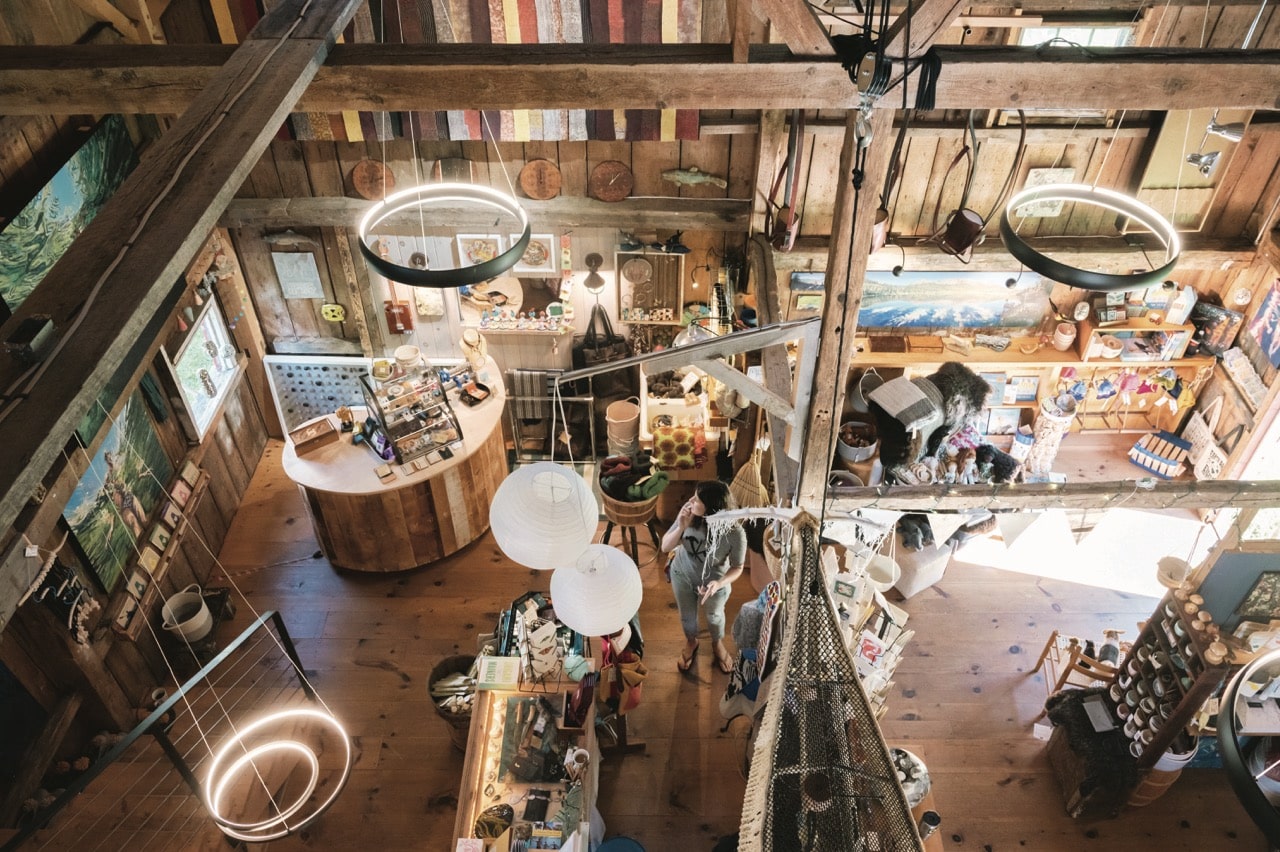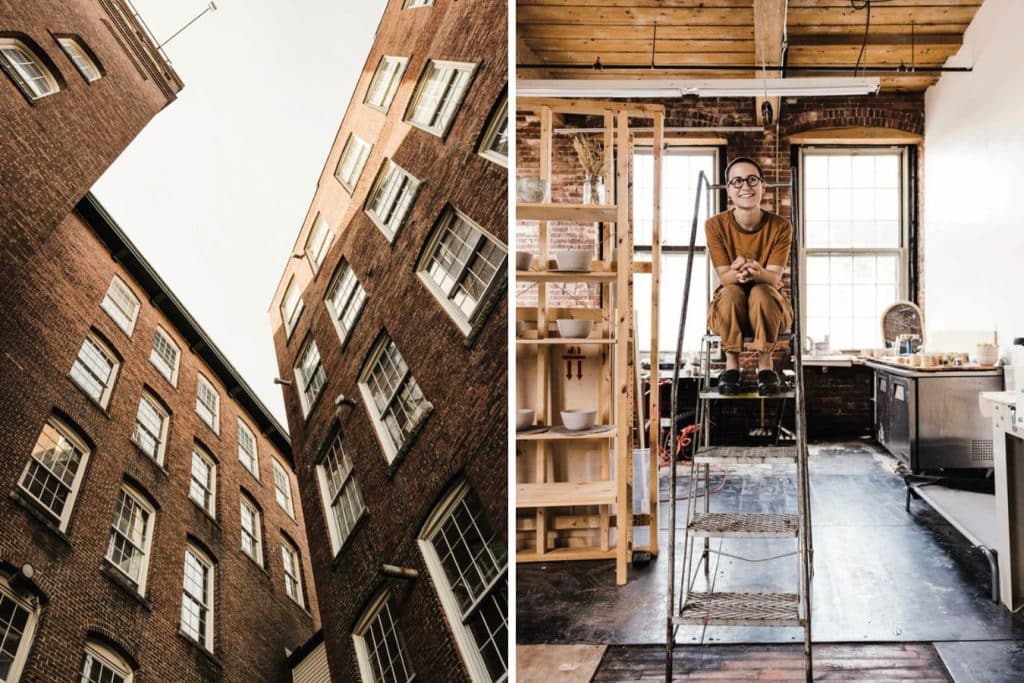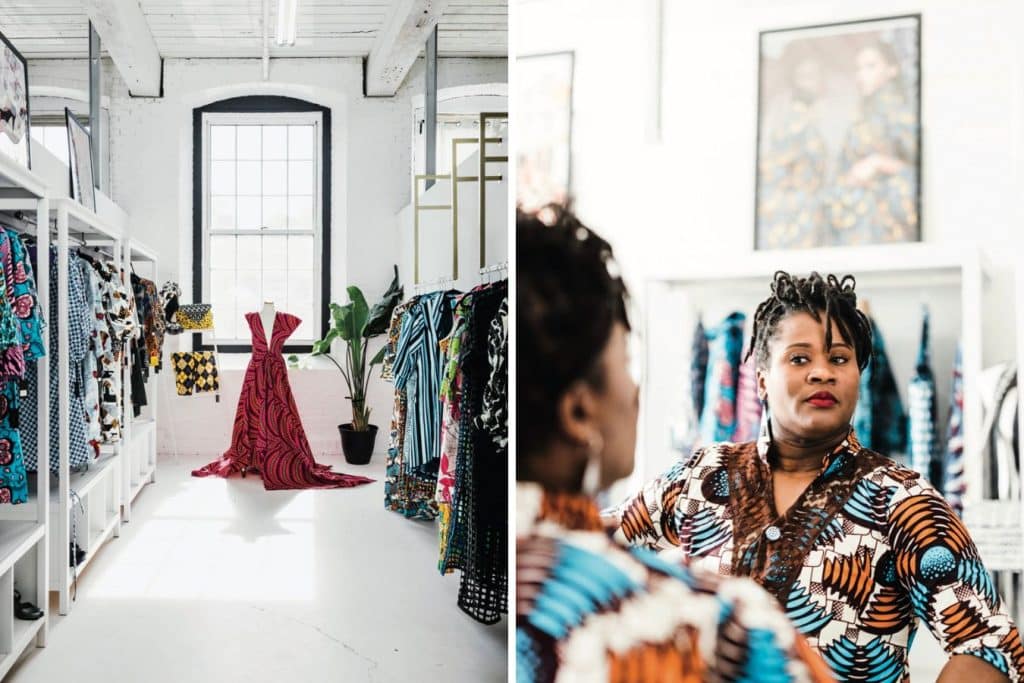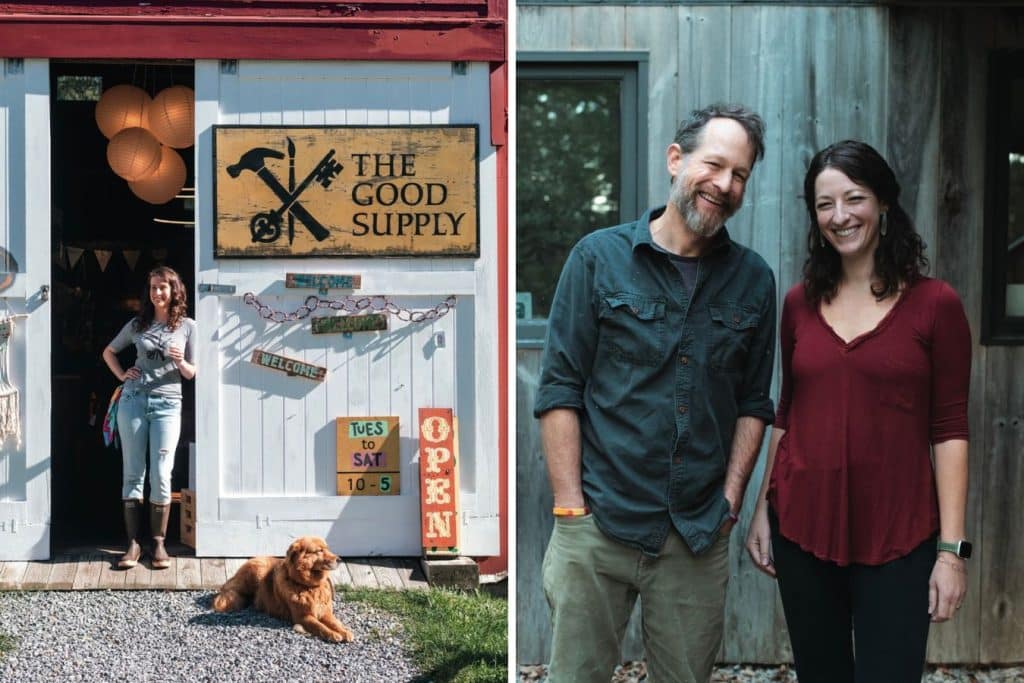Artful Escapes | Best New England Artisan Hubs
These New England artisan hubs blend one-stop shopping with one-of-a-kind appeal.

The Good Supply in Pemaquid, Maine, a beautifully curated shop packed with Maine-made goods.
Photo Credit : Tristan SpinskiIn no special order, and without provocation, I find myself dreaming of tiny enameled earrings shaped like barnacles, blown-glass eggs with a dash of Jackson Pollock, and a tidy stack of laundry stain sticks.
Such is the diversity that springs forth, like creative bedlam itself, when you gather the work of multiple artists and craftspeople into one place—whether shops or galleries, fairs or festivals. From woodcarvers to potters; painters to lithographers; weavers to well-you-get-it, no medium goes unturned. Inspiration is everywhere, and it’s a veritable cornucopia of talents: audacious, satisfying, and unpredictable.
Coincidentally, it is a shopper’s paradise.
Sometimes the venues can be as ingenious as the treasures they contain. Like The Good Supply, a tucked-away gem on Maine’s Pemaquid Peninsula. Owner-curator Catherine McLetchie assembles the art and craft of 100 mostly Maine makers, her community of creatives, and shares them with such infectious enthusiasm you might be inspired to consider relocating to Maine, possibly to join in.
At the other end of the artisanal-shopping spectrum is its urban counterpart: Western Avenue Studios, a former textile mill in Lowell, Massachusetts. The enormous space is home to 250 artist studios with another 50 live-work spaces that open their doors to the public during monthly Open Studio events. With a coffee bar, brewery, gallery, and food trucks, it’s like an art carnival packed into an industrial space.
Let’s duck inside for a closer look.
Best New England Artisan Hubs, Craft Festivals, and Multi-Artisan Shops

Photo Credit : Michael Piazza
Spotlight: Western Avenue Studios in Lowell, Massachusetts
Surely this is what the creative brain looks like, spread over 265,000 square feet.
It’s practically impossible to visualize this amount of space until you see it: a mountain of brick, a massive sign proclaiming Western Avenue Studios, in an industrial neighborhood in the city of Lowell. Unfolding alongside the Pawtucket Canal (a watery antique completed in 1796), this five-building complex could fill four football fields. It could also win an award for most creative repurposing of a former textile mill.
More than 350 artists work or live here, in affordable spaces. It’s an incubator where painting, pottery, jewelry, glasswork, clothing, wood, mixed-media, you-name-it, flow out of studios and into the halls. Even the Tiny Arms café infuses art into its small, tasty menu and cheery pottery, with tables and chairs on full view beyond loading-dock doors, raised up on this steamy summer day.

Photo Credit : Michael Piazza
At least once a month, the Western Avenue studio doors are flung open, and the public gets to explore five floors of creative work, visiting makers in their studios, shopping an extraordinary array of crafts. Wander at will or take one of eight self-guided tours. Duck into the Loading Dock Gallery, filled with juried items. When you’re ready for a pick-me-up, there’s Navigation Brewing Company, or assorted food trucks, like the Plantiful Food Trailer, with a veggie sushi bowl and homemade lemon-lavender seltzer to stoke you up.
Impossible to predict what you’ll encounter.…
“Would you like to buy a bookmark?”
I’ve just climbed down a flight of industrial stairs (there are elevators, too) to start at the beginning, on Floor 1, one story below the entrance. And here I encounter siblings Melinda, David, and Shmuel—young entrepreneurs who are eager to share their work, and excited when I buy three. Then they take me to meet their mother, Queen Allotey-Pappoe, who is standing in her gallery, surrounded by the colors of Ghana and the vibrant clothes she makes from them. She is tweaking the Manye (translates to “Queen”) vest a customer is trying on, and it’s probably safe to say this woman has never worn anything quite so full of joy.
“I’ve been dressing women as long as I can remember!” says Allotey-Pappoe, the creative director of her clothing line, Queen Adeline. Her “wearable art” is steeped in sustainability: “I want to help reduce waste in closets, and I only use 100 percent cotton,” she emphasizes. Fabrics that her mother buys in Ghana, and brings to her. “I ask for one thing, she comes with something else,” Allotey-Pappoe nods her head. “And she’s always right!”

Photo Credit : Michael Piazza
The clothes are electrifying. A celebration of women as birds of paradise, capable of wearing magenta geometrics, melon-colored pinwheels, indigo dots in rippling circles. “I express myself in color and print,” she says. The silhouettes are timeless, with pockets “to hide our sins.” She pauses for effect: “And for lipstick!” She is the self-appointed Chief Joy Officer at the studios, even on bad days, because “that energy works for itself. That same energy picks me up!”
Back in the hallway, I set off down a corridor that reminds me of a village street, with alleyways spinning off in different directions. A medieval township of creatives. Who lives behind this door? Or this one?
A hanging handsaw points the way to Woodworkers Row, and I step inside Eric White’s stump-studded workshop. His aptly named Spalt Studio is a forest of lathes and chisels, bristling with woodworking implements. A woodturner by night, he’s also executive director of the Boston Society of Architects, with a past that includes Old Sturbridge Village. Chunks of raw local wood, many salvaged from the side of the road, are heaped to one side, like potential waiting to be polished: a natural-edge oak bowl; swirling grains in slender catalpa; a spalted maple vessel that explores the infinite patterns caused by decay (the definition of spalting); shelves filled with the beauty of trees at every stage of life.
White tells me that Western Avenue is a real community, and I decide to take my time. Each stop turns into a visit, a chance to learn about someone else’s art, what it means to them. And how we can connect through it.
The floors unroll their makers. Here, at MJ Porcelain, are Myong Jung’s hand-built porcelain ears of purple corn, flames of pink asparagus, folds of red cabbage, influenced by 18th-century European work, but blooming out of her experiments with traditional Korean ceramic techniques.
Peter Zimmerman, at Designs in Glass, calls himself “just your friendly neighborhood glass blower,” but his intricate “marbles” contain starry realms—the cosmos captured in glass orbs.
He shares the studio with Tracy Levesque, aka the Birch Lady. I’ve spotted some of her paintings hanging in the halls, but now, in the studio, I’m surrounded by brilliant birches meeting overhead, vibrating in rich autumn colors, or bathed in a lunar glow, in a style she terms “fairy-tale realism.” Reminiscent of our own world, but “just a wee bit more mysterious and magical.”
Which, in many ways, mirrors this transformed mill building, a place that calls itself “The Creative Soul of Lowell.” Giant paintbrushes dangle overhead in a hallway. Underneath, Hope Greene’s eerie black-and-white photos use antique and modern processes to convey a mix of landscape, myth, and the mind. Over there, a deep velvet maroon couch and chairs to sink into—did I just time-transport into a Victorian parlor? A vitrine displays hand-poured, small-batch Mill City Mercantile candles: Anjou Pear and Woods. “Not All Candles Are Created Equal,” the makers proclaim.
Down yet another corridor, I’ll encounter Barbara Fletcher’s 3-D collages, dark yet hopeful visions of birds and hatching worlds. I pass the Middlesex Bindery on Floor 3, with a stunning faux wall of antique books. Bruce Wood’s dystopian visions of Marvel-Comics-meeting-Tom-Swift spill out from his Glass Ingot workshop. His might be the craziest stop of all: found objects reassembled into antique diving suits, aviators wearing gas masks, fish with comb-like teeth, mad-scientist lamps.
Time for a cappuccino, to sit and let this “creative soul” sink in. I’m inspired and heartened by what I find, the artists I have met. Yes, I certainly shopped. But I came away with a lot more.
Open studios held monthly.

Spotlight: The Good Supply in Pemaquid, Maine
The rain is thundering down, rattling the roof, and this two-story weathered barn, set in a pastoral landscape, is not only providing shelter—it’s dressed top to bottom with enough artwork and handcrafted housewares to conjure a deep sense of home. In fact, I’m ready to move in. “I hear that all the time,” Catherine McLetchie tells me, smiling with genuine delight, as another wave of visitors rolls through the door.
Getting lost is half the fun of getting away, and it certainly feels like I’ve driven off the map. The Pemaquid Peninsula—a picturesque tentacle dangling off Maine’s Midcoast—is only about an hour and a half north of Portland, and it ticks every Maine box. Scenic beauty, lobsters, weathered shingles, rugged cottages. Harbors dotted with fishing boats, crying gulls. Also, a scent of fresh fried fish, which draws me to Pemaquid Seafood right before pulling into The Good Supply.
When McLetchie greets a new customer—“Buckeyes!” she calls out, spotting a sweatshirt—I make friends with “G,” her amiable retriever, and take in the large oil paintings gleaming against rough barnboards. “She’s a real Mainer, doing real Mainer art,” McLetchie says of Jessica Ives, whose sunstruck waterscapes feature swimmers and fishermen. And while I’m certainly no fly caster, I take a deep dive into this painter’s feel for water.
Barn boards and warm light make a good canvas. Liz Martone’s glass mosaics shimmer like shards of shattered light: aqua, black, sea-green. Art dangles from the rafters, literally—leathery sculptural pieces that are the work of Colby College sculpture professor Bradley Borthwick. Among the other notable artists sharing the barn boards is George Mason, whose meditative “relief tapestries” combine encaustic with layered paper cutouts.
McLetchie started The Good Supply in 2012, in a small shed behind the 1850s barn, which was a wreck. A year later, it emerged from the ruins a proud post-and-beam, filled to the rafters with McLetchie’s vision. Housewares were just the beginning, but what housewares: benches draped in Betsy Leighton’s riotously colorful merino wool blankets, alongside her Bowerbird Studio Japanese-style linen aprons. Pottery pieces jostle on cupboard shelves—gold-rimmed porcelain cups that Alexsondra Tomasulo imbues with a “stopping-by-woods” feel that even Robert Frost might fancy. They face off against Soozie Large’s ceramic whisky shot glasses in … chartreuse! Tangerine! Sunflower!
Not to ignore the graphic tea towels by Allison McKeen, and Erica Moody’s forged brass and copper pie servers, but honestly things are tucked in and around everywhere. Like those laundry stain sticks from SoulShine Soap Company that McLetchie swears will remove anything. They’re spilling out of a fragrant corner anchored by a vintage sink filled with other goodies: Copper Tail Farm goat-milk soaps, Island Apothecary body oils, LooHoo’s woolly dryer balls.
Impossible not to touch Tim Christensen’s one-of-a-kind sgraffito porcelains—songbirds and sea life encircle vessels that nest, soar, and defy category. “He wants to make art that people 300 years from now will understand without speaking English,” McLetchie tells me. The practical arts are not ignored, either: here’s a Snow & Nealley splitting maul, the gold standard, hand-tempered in Maine with a lifetime guarantee. A rack filled with Saturn Press cards—letterpress beauties printed on Swan’s Island since 1986—features a slew of Maine’s romantic images: moons, canoes, starry dandelion seeds, brilliant red lobsters.

Photo Credit : Tristan Spinski
How is it that I’ve barely moved beyond a few steps, with so much more for me to take in? The barn continues bustling, and now so do I. What about those chunky rings and beaten bangles from Coco Corral’s Loving Anvil? Incorporating raw gemstones, or personal messages hammered into reclaimed brass, silver, and gold? Or these tiny barnacle earrings, rendered in mustard and sea smoke enamel, fresh from metalsmith Kate Mess’s workbench, that evoke “the stubborn crustaceans” she’s observed in her surroundings on the Maine coast?
McLetchie hands me an invitation to her annual summer art party, still a few months off. We all get one, everyone who comes through the door, and Liz Martone—she of the glass mosaics, mentioned earlier—joins the conversation. She’s a close friend and now co-curator in this artistic adventure, helping McLetchie fill the barn with art, craft, community. “Friends for real,” they call it. That phrase comes up a lot, not just with each other, or about the artisans who’ve gathered under this roof, or even when they talk about the yearly art party. We’re all included, all invited, all asked to be part of the barn magic.
Magic that also happens to include a moose puppet. A Shepherds’ Craft Farm ushanka hat that looks like something the Little Prince might wear on other planets. And this glow-in-the-dark Ruth Bader Ginsburg poster. Friends for real.
Open May–October and holidays.
More Craft Festivals and Multi-Artisan Shops to Explore:
Artisans’ Gallery, Waitsfield, VT
Hand-built ceramic birdhouses and brighter-than-life canvases of the Vermont countryside are just a few of the teasers in this 1830s co-op storefront representing more than 150 Vermonters.
Frog Hollow Vermont Craft Gallery,Burlington, VT
The nation’s first state craft center—in the center of busy Church Street—rotates the work of 200-plus Vermonters, with items ranging from hand-carved Windsor chairs to blown-glass fish to Noguchi-style light sculptures.
League of NH Craftsmen Fair, Newbury, NH
Under tents at the base of Mount Sunapee, more than 300 juried artisans bring their best to this nine-day August event, one of the nation’s oldest craft fairs, now celebrating its 90th anniversary. The league also has seven year-round galleries around the state, with wares from its 700-plus juried members.
Paradise City Arts Festival, Northampton/Marlborough, MA
A showstopper that feels like a festival; an extravaganza with 200-plus top-notch craftspeople and fine artists. Artists Linda and Geoffrey Post have been showcasing creativity since 1995 with an event that is its own work of art. March, May, October, November.
Field of Artisans, South Kingstown, RI
Who doesn’t love a pop-up market? And when it’s a field of artisans, it’s truly a field day. Since 2015, creators from around New England have joined an ever-expanding network of more than 700 makers, many of them hailing from Rhode Island, ready to pop up at venues ranging from the General Stanton Inn to South Kingstown Town Beach.
Guilford Art Center Craft Expo, Guilford, CT
This annual outdoor juried show held in July gathers some 180 artisans on beautiful Guilford Green. The center is also a year-round destination for artisan-made crafts, displaying everything that its 100-plus juried makers can dream up, with summer pop-up events.
Island Artisans, Bar Harbor and Northeast Harbor, ME
A showcase for more than 100 Maine artists and makers at two galleries. The owners offer their own hand-spun, hand-dyed yarn, wearable fiber art, and one-of-a-kind clocks.
United Maine Craftsmen Shows, Augusta, Brewer, and Portland, ME
For 50 years, the state’s largest nonprofit craft organization has highlighted Maine’s talent in a juried show that kicks off the holidays, with shows in November and December.
Do you have a favorite spot to shop for New England art and crafts? Let us know in the comments below!
Annie Graves
A New Hampshire native, Annie has been a writer and editor for over 25 years, while also composing music and writing young adult novels.
More by Annie Graves

